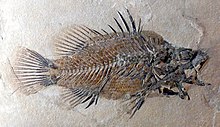Monte Bolca

Monte Bolca is a significant fossil site of Eocene near the Italian city of Verona .
Monte Bolca is not far from the village of Bolca and is also called Pescaria ("fish bowl") because of the numerous fish fossils . In a broader sense, the nearby sites are also referred to as Monte Bolca .
The area around Monte Bolca was lifted from the sea floor twice during the unfolding of the Alps , once 30 to 50 million years ago, and again 24 million years ago. The site consists of a 19 meter thick fossil-rich limestone layer . Particularly well-preserved fossils can be found in individual horizons . Not only are the internal organs visible here, but the color of the skin can even be determined.
Monte Bolca has been known as a fossil site since the 16th century and has been the subject of intensive scientific studies since the 19th century. Louis Agassiz (1807–1873) was one of the scientists who dealt intensively with Monte Bolca. Giovanni Serafino Volta published a book about the fish fossils found there as early as 1796.
Web links
Coordinates: 45 ° 35 ′ 40 " N , 11 ° 12 ′ 36.1" E